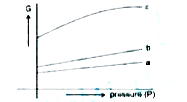Assertion: Under adiabatic free expansion, (dUdV)T is +ve when attractive forces are dominant between gas molecules [U,V,T respresent internal energy, volume and temperature of gas respectively]
Reason: Internal energy is a state function.Solution in Telugu
Statement-I is true, statement-II is true and statement-II is correct explanation for statement-I
Statement-I is true, statement-II is true and statement-II is NOT correct explanation for statement-I
Statement-I is true, statement-II is false
Statement-I is false, statement-II is true
The correct Answer is:D
Step by step video, text & image solution for Assertion: Under adiabatic free expansion, ((dU)/(dV))_(T) is +ve when attractive forces are dominant between gas molecules [U,V,T respresent internal energy, volume and temperature of gas respectively] Reason: Internal energy is a state function. by Chemistry experts to help you in doubts & scoring excellent marks in Class 12 exams.
Topper's Solved these Questions
- BOOK - AAKASH SERIESCHAPTER - CHEMICAL THERMODYNAMICSEXERCISE - Practice Sheet- Exercise-III30videos
CHEMICAL THERMODYNAMICS
- BOOK - AAKASH SERIESCHAPTER - CHEMICAL THERMODYNAMICSEXERCISE - Practice Sheet- Exercise-IV20videos
CHEMICAL THERMODYNAMICS
- BOOK - AAKASH SERIESCHAPTER - CHEMICAL THERMODYNAMICSEXERCISE - Practice Sheet-Exercise-I33videos
CHEMICAL THERMODYNAMICS
- BOOK - AAKASH SERIESCHAPTER - CHEMICAL KINETICSEXERCISE - Objective Exercise - 4 (Assertion (A) & Reason (R) Type Questions)44videos
CHEMICAL KINETICS
- BOOK - AAKASH SERIESCHAPTER - CHEMISTRY IN EVERY DAY LIFEEXERCISE - PRACTICE EXERCISE29videos
CHEMISTRY IN EVERY DAY LIFE
Similar Questions
The following curve represents the variation of Gibbs function 'G' with pressure at constant temperature. Correct match of given plots with the physical state of a substance is
 02:09View Solution
02:09View SolutionFor a perfectly crystalline solid Cp.m=aT3, where a is constant. If Cp.m is 0.42 J/K − mol at 10K, molar entropy at 10K is
01:18View SolutionWhich of the following diagram correctly represents the variation of internal energy (U) of gas under expansion at constant temperature.
02:20View Solution(A) Spontaneous reaction may be slow or fast.
(R ) Spontaneous nature deals with feasibility of the reaction but not rate.04:23View SolutionAnti allergy drugs are
02:47View SolutionAssertion : Internal energy of an ideal gas does not depend upon volume of the gas. Reason : This is because internal energy of ideal gas depends only on temperature of gas.
01:35View SolutionAssertion:−Internal energy of a real gas may change during expansion at const. temperature.
Reason:− Internal energy of a real gas ia function of T & P.03:09View SolutionIn an adiabatic expansion of a gas initial and final temperatures are T_(1) and T_(2) respectively, then the change in internal energy of the gas is
02:43View SolutionAssertion In adiabatic expansion the product of p and V always decreses
Reason In adiabatic expansion process, wrok is done by the gas at the cost of internal energy of gas.01:55View SolutionStatement-1: Under adiabatic free expansion, (dUdV)T is +ve when attractive forces are dominant between gas molecules [U,V,T respectively]
Statement-2: Internal energy is a state function.01:04View SolutionAssertion. The temperature of a gas does not change when it undergoes an adiabatic expansion. Reason . During an adiabatic expansion of a real gas, the internal energy of the gas remains constant.
02:43View SolutionAssertion : The internal energy of a real gas is function of both, temperature and volume.
Reason : Internal kinetic energy depends on temperature and internal potential energy depends on volume00:57View SolutionIf the internal energy of an ideal gas U and volume V are doubled, then the pressure of the gas :
03:02View SolutionAn ideal gas (whose CpCv=λ, and internal energy U at absolute zero temp. is equal to zero) undergoes a reversible adiabatic compression. If U,p,V,T Represent the internal energy, pressure, volume and temperature respectively of the ideal gas, then
01:00View SolutionPlot a graph between internal energy U and Temperature (T) of an ideal gas.
02:21View Solution

